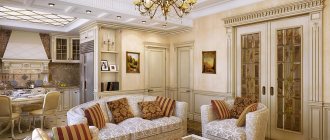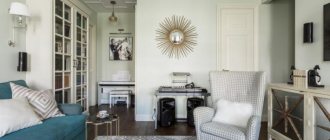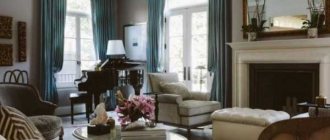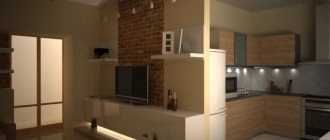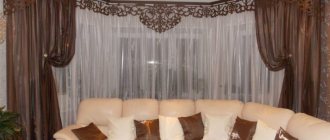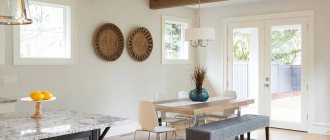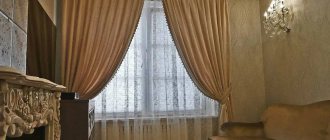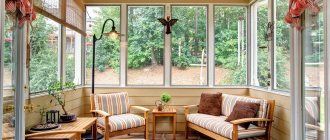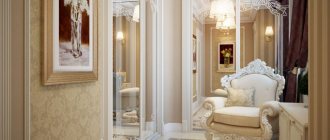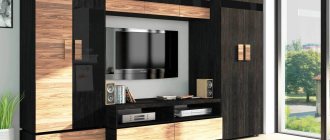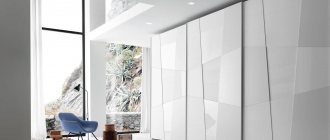In the modern world, more than a thousand styles and trends in interior design have been invented and implemented. Progress does not stand still and we are inspired by such styles as brutalism, loft, hi-tech, minimalism. But still, a special place is given to the noble and elegant classical style. Classics have become an indicator of the status of its owners, emphasizing prosperity and excellent taste, as well as the epicenter of comfort and luxury. In this article, we have prepared detailed material for you, where we will tell you the distinctive features of this style and practical tips for implementing this interior in your home.
Implementation of classic style in the living room interior
Classic style will never lose popularity. He is timeless. Even the name of this design trend has become a household word and denotes consistency and relevance. But to create such a style, you need to follow all the rules. Not only of a technical nature, but also of a stylistic nature. Because it’s very easy to get carried away by mixing different eras and end up with a different style.
Textile balance
Panoramic windows with minimalist trims and frames can be complemented with long draped curtains made of expensive fabrics (taffeta, satin, velvet). If the room is dominated by classics, it is better to hang curtains that are strict and monochrome with a laconic design. An elegant tie with fringe or tassels is another reference to the Renaissance.
The right cushions and bedding are a winning way to combine two styles. To avoid excessive diversity, it will be enough to use one or two pillows with geometric or floral patterns. Textured fabrics in dark tones will add warmth to a light, neutral space.
Decorative decorations
Classic is the standard. Therefore, interior decorations must be present and complement the interior. But it is worth remembering that they have a character of elegance and slight restraint. Pomposity and pretentiousness are not acceptable here. This is a fine line that is easy to step over. Therefore, we will tell you in more detail what types of decor are acceptable to use.
- Stucco on the wall and ceiling
- Fireplace made of natural stone
- Arches and columns
- Refined furniture without weight
- Cornices around the perimeter of the room and above the windows
- Textiles and furniture made from natural materials
- Mirrors and paintings in carved frames
- Candlesticks with monograms
- Large chandelier in a classic frame
- Plaster sculptures
- Accessories: vases, boxes, watches, antiques
Striving for symmetry
Contemporary, like classic, works best in spacious, open-plan spaces with clear rectangular or square shapes. The space should smoothly flow into one another with the compositional center - the living room. For zoning, classical architectural elements are often used: arches, columns, semi-arches. They can be created using modern and inexpensive materials: drywall, MDF, plastic.
The room should not be overloaded with pieces of furniture and decor. Both styles strive for space, order and maximum illumination. They can be achieved thanks to panoramic glazing, a light palette and laconic furniture around the perimeter. The important rules of neoclassicism are strict symmetry and restraint in everything: from the organization of space to ornamentation in decor.
Room zoning
The functional areas in this interior have clear boundaries. This is the main feature of a classic interior. They are located in accordance with the built symmetry and are located at some distance from each other.
Lights and accessories
Modern classics require a lot of bright light, but they are skeptical about interior accessories, leaning almost towards minimalism. Wall paintings and decorative columns are often used as decorations. In addition, suitable
- reproductions of paintings;
- mirrors;
- figurines;
- live plants;
- vases with flowers;
- lamps, floor lamps;
- sofa cushions.
Textiles are of great importance in the decor of such interiors - curtains, rugs, chair covers made of linen, velvet, silk, and satin. The texture of the fabrics can be matte, glossy, with a pronounced coarse weave. Carpets on the floor are classic with high pile or stylized as tapestries.
The lighting of a modern classic interior is multi-level, formed by point elements. LED strips are not used; they are closer not to classics, but to minimalism, hi-tech. Neoclassicism takes shape
- chandeliers - multi-arm models with fabric, glass, porcelain, ceramic shades, on a metal frame with a forged base;
- wall sconces, floor lamps with soft diffused light in functional areas - near an armchair, sofa, entrance area;
- table lamps - in the office, by the bed, next to audio equipment, clocks.
The modern classic style in the interior is attractive, popular, and applicable to residential premises of any type and size. Creating such a design project is a painstaking, voluminous work that only professionals can handle. Trust your comfort and coziness to Nikona Stroy designers. Examples of already completed apartments and houses can be seen in their portfolio.
Functional areas of the living room
- Rest zone. There is a coffee table, next to a sofa and cozy armchairs, as well as a stand with a TV. Sometimes a carpet is laid underfoot to further highlight this area.
- Dinner Zone. A massive table and chairs included are a must. If desired, the design of this area is complemented with a carpet.
- Conversation area. Several chairs in front of the fireplace, or in any other part. Sometimes it is equipped with a small table.
- Desk area. A small corner where you can write a letter. There are several beautiful floor lamps here. There is no talk of any computer here; for this there should be a separate room - an office.
- Reading area. Shelves are installed here and a small library is equipped. This area is also complemented with a cozy sofa and armchairs.
Free space must be maintained between zones. The location of the zones is implemented according to a pre-developed symmetry scheme. Each element in the interior has its place creating a bohemian atmosphere of luxury and comfort.
Classic color palette
Classic interior design is a balanced combination of color and light. As the interior artist and founder of TB studio explained. Design Tatyana Bezverkhaya: “classics relies on natural, natural and light colors.”
There should always be a base - a common color and, as a rule, a neutral one. If the design is planned to be light, the base will accordingly be “milk”, “pale graphite” or white. This base implies the presence of dark colors to complement. This could be furniture, carpets, tapestry paintings in deep gray and brown shades. The final noble touch is a few spots (pillows, chair upholstery, curtains) olive, purple, emerald spots and “sand”.
According to the same advice from Tatyana, for regions where sunny days are directly proportional to bad weather, a room in a light beige palette will definitely not be the same as in the southern part of France. Therefore, focusing only on white or dark is a mistake. You need a proper balance of cold and warm colors, light and dark.
Classic prefers a calm mood and an orderly construction of color schemes. Often, designers resort to a palette “for its intended purpose”: the bedroom is in a peaceful blue color, the front door is in sunny and welcoming vanilla, the office is in the colors of mahogany and green cloth that historically developed during the war era, the kitchen is a storehouse of “shades of dairy products” ( pink fermented baked milk, stewed milk foam and yellow cheese).
Unacceptable decorations
It is important to know which elements cannot be used in classics. Since at first glance they also belong to this direction, but are taken from other styles. And they will only interfere and create disharmony.
- Ruffles with lush frills
- Fringe on curtains (not to be confused with tassels)
- Blinds on the windows
- Stained glass as the basis of design
- Openwork weaves
- Forging elements
- Floral and floral ornaments
- Careless finishing of floors and walls
- Bright accents
So, we have looked at the main points of a classic interior. All you have to do is take this information and apply this knowledge in your own living room. We have also prepared an inspiring selection of living room design ideas for you. Enjoy watching.
Materials for finishing walls, ceilings, floors
Modern classics do not put forward strict requirements for the choice of finishes. You can decorate the interior in accordance with all the rules of the direction using both classic materials - natural wood, paint, and innovative panels made of plasterboard, plastic, imitating them, and porcelain tiles.
Walls
The best option is plastering and painting. It is allowed to paste with plain wallpaper or with a small geometric pattern, plant or floral patterns. Textiles for walls look and are expensive, suitable only for a living room or bedroom in a modern classic style. The color scheme of wallpaper and textiles should be restrained; if there is a pattern, then in two colors close to each other.
Another option is plasterboard wall panels “like wood”, metallized, with a mirror finish. Door and window openings can be emphasized with protruding platbands to match the leading color. The walls of the bathroom and kitchen in a modern classic style are covered with ceramic and marble tiles.
Ceiling
It should be a perfectly flat, light surface that visually lifts the ceiling. You can place stucco around the central light source - a chandelier - but you cannot highlight its elements with a contrasting color. If zoning is necessary, for example, in a studio apartment decorated in a modern classic design, ceiling beams, curly cornices, and rosettes are used.
Multi-level structures are not welcome, as are drawings and multi-colored lighting. Strictness, simplicity, aristocracy - you can create this effect with the help of paint, stretched woven fabrics, hanging structures made of plasterboard, glossy and matte.
A professional should choose the type of material and color. It is important to calculate the features of the texture, its correspondence to the level, type of lighting, possible changes in shade when changing the intensity, direction of the light flow.
Floor
Natural wood, laminate, linoleum, parquet boards, ceramics, marble - this is not the entire list of materials for finishing floors in the neoclassical style. The modern market offers a huge assortment. When choosing, you should take into account not only the rules of style, but also the load on the floor. In the living room you can lay classic stacked parquet, and for the bathroom and kitchen only marble, porcelain stoneware, and linoleum are suitable.
If you decide to use natural wood, then preference is given to boards made of
- oak;
- ash;
- larches;
- pine trees;
- alders;
- aspen;
- maple.
The color of the floor should be darker than the color of the walls. You can make it more “heavy” - woody, chocolate, but then you will also have to add accents to the interior - furniture, accessories, textiles.
Tips for choosing
Classic-style furniture is usually made from natural wood. If possible, it is better to give preference to rare breeds. Oak, walnut, birch or cherry are suitable. Such products are not made from chipboard. Expensive fabrics that have a spectacular appearance are used for upholstery. These are brocade, silk (for living rooms), velvet, satin (for bedrooms, children's rooms), leather or its eco-modification (for work rooms, hallways, rest rooms in offices).
Characteristic features of furniture in the Art Nouveau style, tips for selection and placement
Typically, manufacturers give preference to natural, soft colors, such as beige, milky white (English furniture), ash gray, pearl, and sand. Against this background, finishing elements shimmering in gold or silver look especially good.
The choice of upholstery is determined solely by the taste of the customer. Some people prefer monochrome solutions, while others like fabric with a pattern. Carvings are often applied to wooden parts that are not covered with cladding - intricate leaves, flowers, twisting vines. Strict geometric patterns in the modern classic style are also invariably popular.
The main task of the decor is to emphasize the nobility and splendor of the style. Furniture makers actively use gilding. Also common techniques for decorating products are glass and metal engraving (American classics), inlay with precious stones, and artistic forging. The facades of cabinets and pencil cases can be additionally decorated with mirror surfaces.
Furniture for the nursery is selected with special care, especially if there is always a small child under three years old there. You should abandon intricate decor for the sake of practicality and functionality. Modern factories produce a wide range of classic-style products designed for different ages. A beautiful and functional interior contributes to the formation of the right aesthetic taste from an early age.
For a children's room it is better to choose furniture in light colors. Appropriate options are white, beige, sand. The abundance of dark brown tones can have a depressing effect on the child’s psyche.
A person with good taste usually chooses something that has stood the test of time. As a rule, this is a classic. The main thing is to purchase furniture from well-known manufacturers, then it will last a long time. You should also remember that truly good, durable and beautiful products will never be cheap.
Home office
The most common style of office design is British classics. Dark shades in the palette. Wallpaper with a small pattern, stripes or checkered patterns. Wooden wall panels decorated with frames. The furniture includes comfortable leather chairs, a wide massive table, and bookcases.
